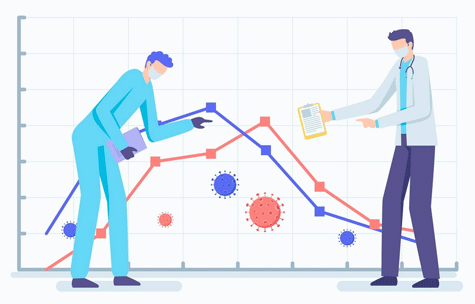Two years later: COVID’s big losers revisited
By Jeffrey Cole
Two years after we first examined the transformative impact of the pandemic on American life, what has changed with shopping, travel, work, mental health and more? Center director Jeffrey Cole digs in.
By Jeffrey Cole
Despite the devastating loss of life (more than one million) and the toll of COVID on the nation’s mental health (especially on those under 25), there were big winners coming out of the pandemic.
The Center’s COVID Reset Project has been tracking seven sectors of American life:
- Physical and Mental Health
- Work
- Learning
- Shopping and Payments
- Homes and Communities
- Travel
- Entertainment
We started tracking just as the nation (or most of it) was getting vaccinated in January 2021, and we have been in the field ever since.
At the end of next month, we will have three years of data, with more to come.
The goal of Reset was (and still is) to see which pandemic changes were temporary and would quickly revert to the ways before COVID (this turned out to be Learning), which changes would revert but would take a longer time (Travel), and which changes were permanent (the move toward cashlessness).
At the end of Year One, we assessed the winners and losers emerging from the early days of COVID. Now, two years later, it is useful and interesting to see whether the winners have maintained their gains, as well as if the losers have seen their standing improve or decline further.
Let’s start with the losers and see if their fortunes have improved, worsened, or stayed the same since the end of 2021.
Losers at the end of 2021
Cash: Despite millions of Americans never wanting to go cashless and fighting the elimination of the penny, COVID forced us into online and contactless payments. Early on in COVID we were concerned that the cash we were exchanging might contain the virus, then we were worried about the merchants themselves being infected.
Inadvertently, that ease of payments, combined with an appreciation for those who came to work during COVID, also led to significant increases in how much and who we normally tipped. New workers and services asked for gratuities, including, inexplicably, for self-service. We are still trying to unwind that mess of knowing who and when to tip—particularly when the “tipee” is standing in front of us.
Of course, cash is still with us, but much less of it. We got used to credit and debit cards, Google and Apple Pay, and now we can see the end of cash in sight. Cash’s position has worsened significantly since 2021.
Uber and Lyft: Ride sharing companies were losers when business came to a standstill during the pandemic, and then were hit by labor shortages as we came out. The subsidies provided by investors since the companies were formed were running out. That loss, coupled with a lack of drivers, led to significant price increases. Just last week Uber and Lyft were fined $328 million by the state of New York for unfair labor practices. We still rely on the services, but their large price advantages and convenience over taxis has lessened. Their position has remained about the same.
In-person shopping: When it felt safe, shoppers flocked back to stores to see and touch products and to be around other shoppers. We wanted to shop, but we went home to buy. The pandemic made even those who had never shopped online comfortable doing so. The good news for stores is that while digital shopping is a permanent part of buying, more people are buying in stores than at the end of the COVID lockdown. The retail position has improved somewhat.
Commercial Real Estate: At the beginning of COVID, only 10% of office workers said they wanted to return to the office as before. A war has erupted between employers, who want people back in the office all or most of the time, and workers, who want much more flexible schedules. So far, the employees are winning with three-days in office work weeks. A recession or automation may put the power back in the hands of the employers. Massive vacancies in commercial real estate exist and have gotten worse as new buildings are finished and enter the marketplace. It’s a great market for renters.
There still is not good data on how remote working is affecting productivity and output. It may take years to see the impact of working from home on company culture and team mentoring. Of all the changes that occurred during the pandemic, this is the one that is least settled on where it will land. There are two sides with strong interests and opinions and little prospect of an easy settlement. Position for commercial real estate: worsened.
Business travel: We estimated that one-third of business travel would never return. Employees and, more importantly, their bosses learned that many meetings and conferences could be held over Zoom and other conference apps.
Our analysis was that travel to maintain business and to attend meetings would take a permanent hit. The advantages in costs, less time away from the office, and less stress on the traveler (although some welcomed it) would permanently change the business travel landscape.
The part of business travel that we believed would rebound quickly was to establish business. The trust that comes from shaking hands (which to our surprise, along with hugging, made a quick return) does not get built on Zoom. These in-person behaviors, impossible to replicate online, coupled with sharing drinks or a meal, form the foundation on which business relationships are built. Once built, they can be maintained on an app. The position of business travel has stayed the same.
The goal of Reset was (and still is) to see which pandemic changes were temporary and would quickly revert to the ways before COVID, which changes would revert but would take a longer time, and which changes were permanent. At the end of Year One, we assessed the winners and losers emerging from the early days of COVID. Now, two years later, it is useful and interesting to see whether the winners have maintained their gains, as well as if the losers have seen their standing improve or decline further.
Mental health: Gen Z demonstrated struggles with loneliness, anxiety, and depression long before COVID: it is the first generation that has had digital technology and social media all their lives. During the pandemic, mental health went off the rails for many. The confinement, lost opportunities, and just plain boredom (coupled with fear), weighed heavily on our mental health.
In The Great Resignation—It’s not about jobs, it’s about mental health, I argued that never before had so many looked into their souls at the same time. We were searching to see if our lives were where we wanted them to be, or if they were in need or tweaking or correction. Half thought they were.
Even coming out of COVID, many carried scars and found it difficult to reacclimate to crowds or other people. Appointments with therapists were almost impossible to get. Other signs of a crisis in mental health: speeding, road rage, and traffic accidents, airplane tantrums, and other public displays of anger and aggression were at all-time highs. Many people seemed like power kegs about to explode.
Of those who did not explode with rage, many expressed little interest in buying objects or expensive goods. The number one preference was to have experiences with family and friends. Leisure travel was off the charts (with prices to match), as was eating out as restaurants which—while blessed with massive demand—were cursed with staff shortages. And, in what shows a real change in behavior, the most popular time for dining in fine restaurants moved from 8:00pm or 8:30pm to 6:00pm.
Many emerged from the pandemic with a form of PTSD. Just as many who lived through the Great Depression carried it with them the rest of their lives, so too will COVID remain with many of us in our psyches and fears. All this, in addition to the great divisions in our politics and attitudes toward the opposition, shows a continuing and growing mental health crisis. The position of our mental health has worsened significantly.
Next time: What about the winners?
____________

Jeffrey Cole is the founder and director of The Center for the Digital Future at USC Annenberg.
See all columns from the center.
November 8, 2023


